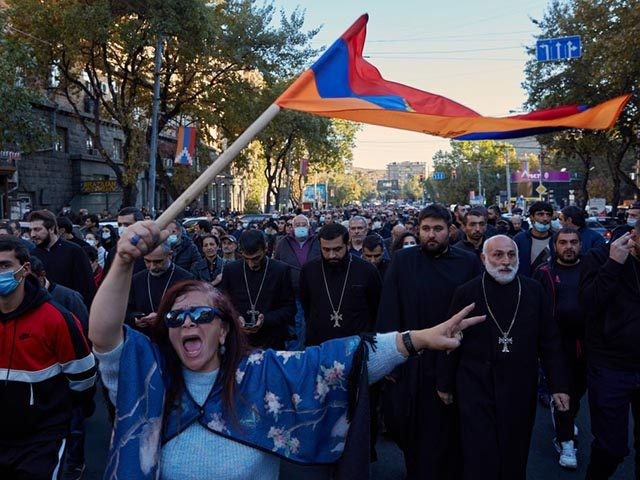Armenians nationwide have draped hundreds of black banners in their local communities bearing the names and ages of soldiers and volunteer fighters killed in the recent conflict between Armenia and Azerbaijan over Nagorno-Karabakh.
Fighting over the breakaway territory began on September 27 and ended through a Russian-brokered peace deal on November 10.
RFE/RL sent a photojournalist to the Armenian capital, Yerevan, and its surrounding area to document a local custom in which villages hang a black banner on the street where a fallen Armenian soldier lived. The mourning ritual “dates back to at least the first conflict over Nagorno-Karabakh, which ended in 1994,” according to the broadcaster.
In Photos: Black banners on the streets of Armenia mark the grim toll of the conflict. https://t.co/WA6NuzxFdH
— Radio Free Europe/Radio Liberty (@RFERL) November 11, 2020
RFE/RL included commentary from an Armenian woman who said she lived through the first Nagorno-Karabakh war in its photo essay. She said she recognized the black banners, writing on Facebook:
The current situation is, of course, different. One thing has not changed, though: the sight of big, black strips of canvas hanging on the streets with a name and age. I saw so many of those as a child, but I’m not sure I fully comprehended what it meant – shattered dreams, devastated families, pain that will never ever go away.
“As a friend wrote recently: Those boys should have been falling in love, not falling in war,” the woman added.
Over 1,200 Armenian fighters and roughly 45 civilians died in the most recent conflict over Nagorno-Karabakh, officials said.
“Azerbaijani authorities do not release military losses but say nearly 100 of their civilians have been killed,” REF/RL reported.
Armenian Prime Minister Nikol Pashinyan announced a peace deal ending the recent fighting over Nagorno-Karabakh on Monday.
“I have signed a statement with the Presidents of Russia and Azerbaijan on ending the Karabakh war at 01:00 [local time],” he wrote in a statement posted to his official Facebook account.
“I made that decision as a result of an in-depth analysis of the military situation and the assessment of the people who know the situation best,” Pashinyan explained.
“I kneel before all our martyrs. I bow to all our soldiers, officers, generals, volunteers who have defended and are defending the homeland with their lives,” the Armenian leader added.
Nagorno-Karabakh legally belongs to Azerbaijan but has been ruled by ethnic Armenian separatists since they seized the region in 1991 after the collapse of the Soviet Union. A three-year war between the two sides followed the land grab, resulting in nearly 30,000 casualties. An uneasy ceasefire in 1994 ended the war, although sporadic skirmishes over the territory have broken out regularly since then. The most recent Nagorno-Karabakh conflict caused the highest number of casualties in fighting over the region since the post-Soviet war.
Prior to the November 10 peace agreement, Russia had tried to negotiate two separate ceasefires between Armenia and Azerbaijan to end the conflict in October. The United States also attempted to negotiate a ceasefire between the two sides on October 26. All three attempts were unsuccessful.

COMMENTS
Please let us know if you're having issues with commenting.